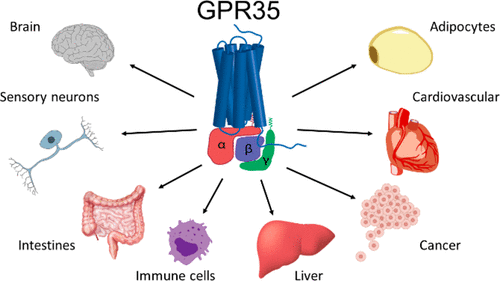当前位置:
X-MOL 学术
›
ACS Pharmacol. Transl. Sci.
›
论文详情
Our official English website, www.x-mol.net, welcomes your
feedback! (Note: you will need to create a separate account there.)
Therapeutic Opportunities and Challenges in Targeting the Orphan G Protein-Coupled Receptor GPR35
ACS Pharmacology & Translational Science ( IF 4.9 ) Pub Date : 2020-07-29 , DOI: 10.1021/acsptsci.0c00079 Tezz Quon 1 , Li-Chiung Lin 1 , Amlan Ganguly 1 , Andrew B Tobin 1 , Graeme Milligan 1
ACS Pharmacology & Translational Science ( IF 4.9 ) Pub Date : 2020-07-29 , DOI: 10.1021/acsptsci.0c00079 Tezz Quon 1 , Li-Chiung Lin 1 , Amlan Ganguly 1 , Andrew B Tobin 1 , Graeme Milligan 1
Affiliation

|
GPR35 is a class A, rhodopsin-like G protein-coupled receptor (GPCR) first identified more than 20 years ago. In the intervening period, identification of strong expression in the lower intestine and colon, in a variety of immune cells including monocytes and a variety of dendritic cells, and in dorsal root ganglia has suggested potential therapeutic opportunities in targeting this receptor in a range of conditions. GPR35 is, however, unusual in a variety of ways that challenge routes to translation. These include the following: (i) Although a substantial range and diversity of endogenous ligands have been suggested as agonist partners for this receptor, it officially remains defined as an “orphan” GPCR. (ii) Humans express two distinct protein isoform sequences, while rodents express only a single form. (iii) The pharmacologies of the human and rodent orthologues of GPR35 are very distinct, with variation between rat and mouse GPR35 being as marked as that between either of these species and the human forms. Herein we provide perspectives on each of the topics above as well as suggesting ways to overcome the challenges currently hindering potential translation. These include a better understanding of the extent and molecular basis for species selective GPR35 pharmacology and the production of novel mouse models in which both “on-target” and “off-target” effects of presumptive GPR35 ligands can be better defined, as well as a clear understanding of the human isoform expression profile and its significance at both tissue and individual cell levels.
中文翻译:

靶向孤儿 G 蛋白偶联受体 GPR35 的治疗机遇和挑战
GPR35 是一种 A 类视紫红质样 G 蛋白偶联受体 (GPCR),于 20 多年前首次被发现。在干预期间,在下肠和结肠、包括单核细胞和各种树突细胞在内的各种免疫细胞以及背根神经节中鉴定出强表达,这表明在一系列条件下靶向该受体的潜在治疗机会。然而,GPR35 在许多方面都是不寻常的,这对翻译路线提出了挑战。其中包括以下内容:(i) 尽管已建议大量和多样性的内源配体作为该受体的激动剂伴侣,但其官方仍被定义为“孤儿”GPCR。(ii) 人类表达两种不同的蛋白质亚型序列,而啮齿动物仅表达一种形式。(iii)人类和啮齿动物GPR35直系同源物的药理学非常不同,大鼠和小鼠GPR35之间的变异与这些物种和人类形式之间的变异一样明显。在此,我们提供了对上述每个主题的看法,并提出了克服目前阻碍潜在翻译的挑战的方法。这些包括更好地了解物种选择性 GPR35 药理学的程度和分子基础,以及新型小鼠模型的产生,其中可以更好地定义假定的 GPR35 配体的“靶向”和“脱靶”效应,以及清楚地了解人类亚型表达谱及其在组织和个体细胞水平上的意义。
更新日期:2020-07-29
中文翻译:

靶向孤儿 G 蛋白偶联受体 GPR35 的治疗机遇和挑战
GPR35 是一种 A 类视紫红质样 G 蛋白偶联受体 (GPCR),于 20 多年前首次被发现。在干预期间,在下肠和结肠、包括单核细胞和各种树突细胞在内的各种免疫细胞以及背根神经节中鉴定出强表达,这表明在一系列条件下靶向该受体的潜在治疗机会。然而,GPR35 在许多方面都是不寻常的,这对翻译路线提出了挑战。其中包括以下内容:(i) 尽管已建议大量和多样性的内源配体作为该受体的激动剂伴侣,但其官方仍被定义为“孤儿”GPCR。(ii) 人类表达两种不同的蛋白质亚型序列,而啮齿动物仅表达一种形式。(iii)人类和啮齿动物GPR35直系同源物的药理学非常不同,大鼠和小鼠GPR35之间的变异与这些物种和人类形式之间的变异一样明显。在此,我们提供了对上述每个主题的看法,并提出了克服目前阻碍潜在翻译的挑战的方法。这些包括更好地了解物种选择性 GPR35 药理学的程度和分子基础,以及新型小鼠模型的产生,其中可以更好地定义假定的 GPR35 配体的“靶向”和“脱靶”效应,以及清楚地了解人类亚型表达谱及其在组织和个体细胞水平上的意义。









































 京公网安备 11010802027423号
京公网安备 11010802027423号